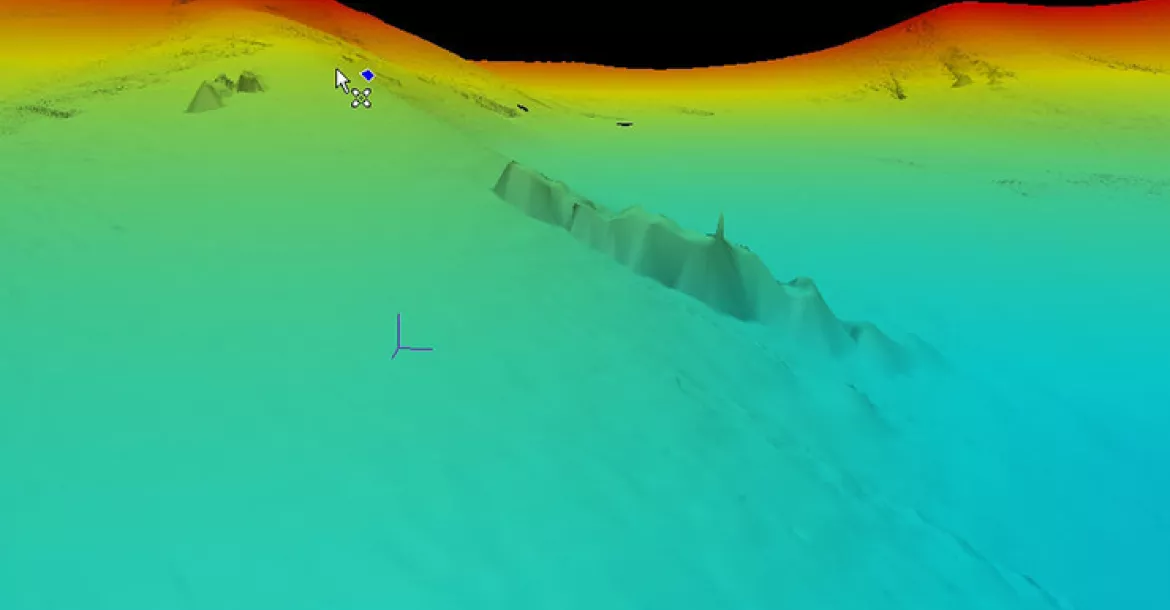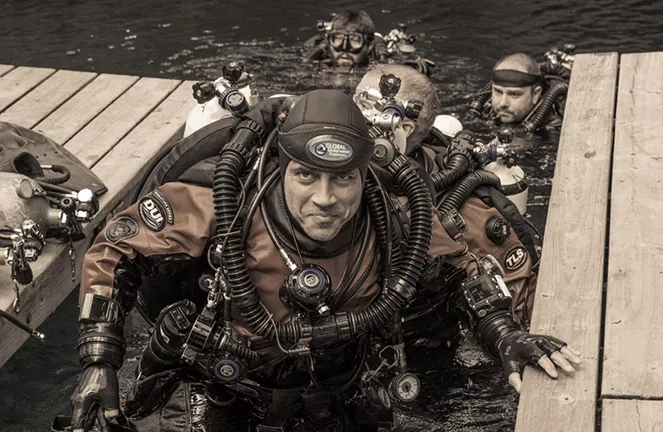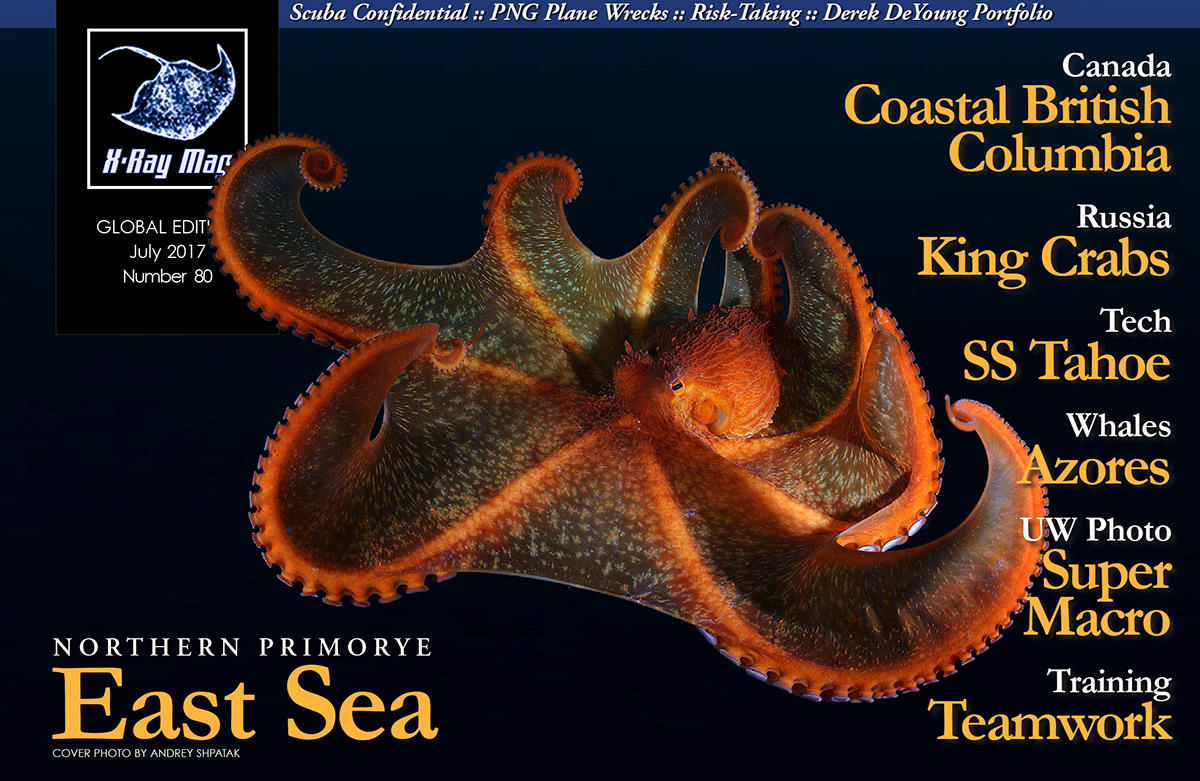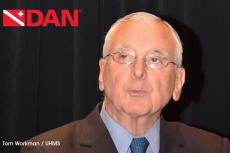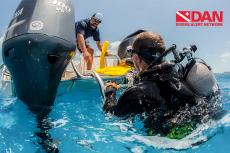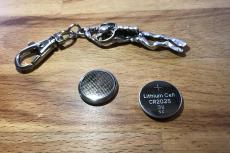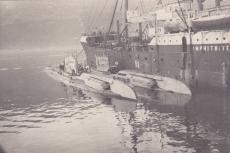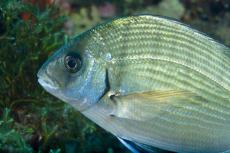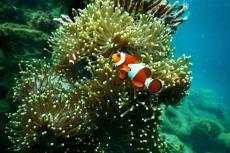June 2017 — Fifty-six-year-old explorer Martin McClellan is determined to revisit the SS Tahoe to conduct an extensive photogrammetric survey of the wreck. The 169ft (52m)-long 19th century steamship, which was scuttled in 1940, rests intact on a steep underwater slope at a maximum depth of 470ffw (144mfw) beneath Glenbrook Bay in Lake Tahoe, Nevada, USA.
Contributed by
Factfile
Michael Menduno is an award-winning reporter and technologist based in California, USA, who has written about diving and diving technology for more than 25 years and coined the term “technical diving.”
He was the founder and publisher of aqua CORPS: The Journal for Technical Diving (1990-1996), which helped usher technical diving into the mainstream of sports diving, and organized the first Tek, EUROTek and AsiaTek conferences, as well as Rebreather Forums 1 and 2.
NOTES:
1Though the NPS manages the National Register of Historic Places, the SS Tahoe is not a NPS managed asset, and Lake Tahoe is not a national park.
2Http://www.projectbaseline.org
3Watch for an upcoming article, “The twenty deepest tech shipwreck dives,” by Michael Menduno.
4Https://en.wikipedia.org/wiki/Boesmansgat
5High profile technical diver David Shaw died on a rebreather dive at Boesmangat in 2005.
6Cross, E. R. (1967). “Decompression for high-altitude diving.” Skin Diver. 16 (12): 60. See also: Cross, E. R. (1970). “Technifacts: high altitude decompression.” Skin Diver. 19 (11): 17–18, 59.
7See: Bell and Borgwardt. (1976). “The theory of high-altitude corrections to the US Navy standard decompression tables.” UHMS. See also: Toner and Ball. (2004). "The effect of temperature on decompression and decompression sickness: A critical review." NMRC.
8According to Pollock, the data for diving and altitude decompression also doesn’t mesh fully. “It is good to be conservative until we have more high quality data to resolve the questions.”
9Https://www.shearwater.com/monthly-blog-posts/on-the-edge/
10Https://www.google.com/maps/place/Lake+Tahoe/@38.742985,-119.6713514,8.35z/data=!4m5!3m4!1s0x809978a1b91f1151:0x8c3f1fafeeafb520!8m2!3d39.0968493!4d-120.0323507
11Https://npgallery.nps.gov/pdfhost/docs/NRHP/Text/04000026.pdf
12Https://en.wikipedia.org/wiki/Ratio_decompression
13Active heating during the working phase of the dive can increase the risk of DCS. See Gerth, Ruterbusch, and Long. 2007. “The influence of thermal exposure on diver susceptibility to decompression sickness.” Navy Experimental Diving Unit Panama City, Florida. Technical Report 06-07. Also see: “The effect of temperature on decompression and decompression sickness: A critical review.” NMRC.
14Http://www.xray-mag.com/pdfs/articles/Feature_GhostFishingII_HeatherH_59_locked.pdf
McClellan was the first to dive the Tahoe with Brian Morris under the banner of his organization New Millennium Dive Expeditions (NMDE) in 2002, and has conducted 10 open-circuit dives on the wreck over the last 15 years. The burly six-foot-two tech diver was instrumental in getting the shipwreck listed on the National Park Service’s National Register of Historic Places in 2004.1 He now wants to return with a team of GUE rebreather divers and high-definition video cameras to create a detailed 3D image of the wreck.
But finding a team of divers with the experience to conduct the dive, which is arguably an exceptional exposure, safely, along with raising the US$10,000-15,000 he estimates will be needed for gas, logistics, accommodations and an appropriate vessel has proved to be a formable task. McClellan was forced to postpone the expedition, which was scheduled for August when several initial team members pulled out, plans for a sufficiently large dive vessel dematerialized, and there was not enough time to resolve other logistical issues, including having sufficient time to complete work up dives for team members. He also got some pushback from GUE leadership regarding the potential riskiness of the dives.
This after printing six-dozen, dated expedition t-shirts using funds donated by local NMDE supporters. “I’m disappointed, but it’s only made me more determined to see this thing through,” said McClellan, who called it a learning experience. “The problem is I can’t do it alone.”
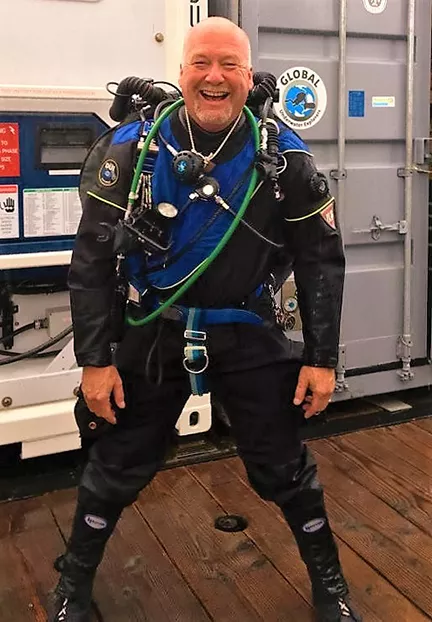
McClellan’s expedition to establish a baseline of the historic shipwreck will be conducted in support of Global Underwater Explorers’ (GUE) Project Baseline,2 and represents the second deepest shipwreck exploration by technical divers in North America. The deepest was Terrence Tysall and Mike Zee’s record three-hour, open-circuit dive on the SS Edmund Fitzgerald at 530ffw (162mfw) in Lake Superior in 1995.
Worldwide the project is the tenth deepest wreck exploration; Leigh Cunningham and Mark Andrew’s 2005 open circuit dive to 668fsw (205msw) on the MV Jolanda near Sharm El Sheikh, Egypt, was the deepest.3
However, unlike the dives on the Jolanda or the “Fitz,” which were conducted at sea level, Lake Tahoe is situated at 6,229 feet (1,899m) of altitude, making the SS Tahoe a no-man’s land in terms of decompression knowledge; there is almost no data to validate procedures for aggressive dives at that altitude. Only Sheck Exley and Nuno Gomes’ series of sub-500ffw (153mfw) open circuit dives in 1992-1996 at Boesmansgat4 sinkhole that lies at an altitude of 5,000ft (1,500m) in South Africa were possibly more extreme.5
In addition, the alpine lake’s bone chilling 39°F (4°C) sub-surface water temperature means that the divers will need active heating for their planned six- to eight-hour rebreather dives, which while keeping the divers warm, could impact their decompression status in ways that are not fully known.
“They [the divers] need to realize that they won’t be in Kansas anymore,” cautioned dive physiologist Dr Neal Pollock, a researcher in hyperbaric and diving medicine at Université Laval, Quebec, upon learning about the project. “They’re a natural experiment, and I would be happy to be there if appropriate planning and readiness is established.”
McClellan is hoping to engage Pollock, whose research interests include altitude decompression and active heating, to monitor and record the dives. “It’s an important opportunity to capture novel data,” the diving scientist explained.
High on diving
It is fair to say that McClellan and Brian Morris, who are both long time Nevadans, spent nearly 20 years developing the needed skills and knowledge for their first dive on the Tahoe. Their first challenge was the altitude.
At altitude, atmospheric pressure is lower than at sea level, so surfacing at the end of an altitude dive produces a greater relative reduction in pressure, and consequently, an increased risk of decompression sickness, compared to the same dive profile at sea level. This is not a problem altered by prolonged stay at altitude. In other words, it is not an acclimatization-related phenomenon, purely a relative pressure phenomenon.
While initial time on the surface at altitude allows the diver to eliminate excess gas and restore equilibrium with the surrounding (ambient) pressure (just like off-gassing after any dive at sea level does), time spent at altitude does alter the implications of greater pressure swings experienced with any dive at altitude. The change in pressure caused by water is stable (with a minor change due to the absence of salt in freshwater), but the surface pressure being returned to is much less, thus increasing the decompression stress associated with any actual depth.
Though Hans Buhlmann and the Defense and Civil Institute of Environmental Medicine (DCIEM) did some work on altitude diving, the most common modifications for diving decompression tables at altitude are the “Cross Corrections,” first presented by legendary columnist E.R. Cross in a 1967 Skin Diver6 magazine column,6 and later validated by researchers7 and adopted by the US Navy. The corrections use the ratio of atmospheric pressure at sea level to the pressure at the relevant altitude to calculate an equivalent sea level depth that represents the same relative pressure changes.
However, the Cross Corrections have rarely been applied to aggressive technical dives at altitude like the SS Tahoe and there is almost no data regarding its efficacy. “The Cross Corrections have been in every US Navy Diving Manual revision since the 1970s. But you can’t rely on them for edgy dives. It’s unclear if the math is sufficient,” Pollock said.8
The atmospheric pressure at Lake Tahoe is 0.79atm, for example, so a dive to 100ffw (31mfw) is the equivalent of making a dive to 100ft x (1atm/0.79atm) = 127fsw (39msw) at sea level. Using the same logic, a dive to 470ffw, the maximum depth of the SS Tahoe, is equivalent to a sea level dive to 594fsw (182msw).
Decompression stops also need to be recalculated deeper, using this method. For example, the 20ft oxygen stop would be pulled at 20fsw (6msw) x (1atm/0.79atm) = 25ffw/8mfw. Note, however, that the partial pressure of oxygen is only PO2=1.52 (= 25ffw/34 ffw/atm + 0.79atm) not 1.6atm, at the adjusted depth.
Though Cross’s articles on altitude diving were useful, they were not a text book, which is what McClellan, then a 21-year-old, newly minted PADI instructor based in Reno, Nevada, needed. So in 1982, he and his math-savvy 18-year-old divemaster, Brian Morris, set out to write a book on altitude diving, which they could use in their classes.
Morris did the math and McClellan simplified the text, and in 1984, they published, Practical Altitude Diving Procedures, which included the first altitude diving tables for Lake Tahoe. They also created a PADI specialty course on altitude diving, at the time when a solid course outline and $25 was all you needed, and began teaching classes at Sierra Diving Center in Reno, Nevada.
McClellan and Morris continued their altitude diving education. In the mid-80s, they ran a series of tests to see how well current dive computers could handle altitude decompression calculations. The Orca EDGE9 led the pack, and Morris created a plastic overlay on the EDGE decompression graphic to correct it for Lake Tahoe diving.
In 1990-91, McClellan opened a dive school and store—Tropical Penguins Scuba in Reno Nevada (later sold)—and continued training divers, at a time when the technical diving was just coming out of the closet. McClellan and Morris got nitrox certified in the mid-90s and began experimenting with trimix.
Subsequently, Morris wrote “Departure,” a Buhlmann-based, desktop decompression program that could handle mix calculations at altitude, and the two began making progressively deeper altitude decompression dives using trimix, and validating the program and procedures. They also started experimenting with pre-breathing oxygen before the dives. Eventually they were conducting trimix dives to 325ffw-350ffw (106mfw) on the slope directly above the Tahoe in Glenbrook Bay.
Beneath Lake Tahoe’s waters
With a depth of 1,645ft (501m), Lake Tahoe,10 which straddles Nevada and California, is the second deepest lake in the United States after Crater Lake (1,943ft, or 592m) in Oregon and occupies 191 sq mi (495 sq km)—enough water to cover the state of California to a depth of 14 inches (36 cm). By the late 1800s, the lake supported a vacation resort with a handful of hotels and communities scattered around its shores, which were serviced by a number of steamers.
In 1884, lumber magnate Duane Leroy Bliss ordered the steel-hulled SS Tahoe from San Francisco’s Union Iron Works. The vessel was shipped by rail in pieces to Carson City, then by wagon to Glenbrook, reassembled, and launched in June 1896. It was the largest of the lake steamships. She was propelled by two wood-fired engines, which developed a total of 1,200 HP (890 kW) each driving a three-bladed propeller. Her 200 passengers enjoyed a well-appointed interior, with leather upholstery, carpeting and marble fixtures in the lavatories. Modern technologies included electric lights and bells, hot and cold running water and steam heating.
From 1901, the SS Tahoe operated from a railroad pier in Tahoe City during the summer, leaving in the morning, making a daily circuit of the shoreline communities, and returning in late afternoon. In addition to the passengers, she carried freight and mail. However, the completion of a road for cars to drive around the lake in 1934-35 along with the loss of its mail contract in 1934 to “Marian B,” made the Tahoe uneconomical to operate, and she lay unused for several years.
In 1940, Bliss’s son repurchased the vessel from Lake Tahoe Development Company; his intent was scuttle her in shallow water off Glenbrook where she would be visible to the glass-bottomed boats that operated on the lake as a memorial to a bygone era. The Tahoe was scuttled on August 1940, but Bliss didn’t take into account the steep 32-degree underwater slope in Glenbrook Bay, and the ship slid down out of sight and came to rest along the slope with the bow at 360ffw (110mfw) and the stern at 470ffw (143mfw).
Tech Target Tahoe
Having a deep technical diving target in their backyard, and a reliable altitude decompression program, proved a compelling combination for McClellan and Morris, who, by 2001, had completed their mix diving certification along with GUE training, which McClellan said was key in preparing them for their 2002 expedition.
“The SS Tahoe was a real motivation,” McClellan recalled. “It was an opportunity to test our deco software, and then we got into the ship’s history. At that time, we had no idea of the effort that would be required to make the dives and secure the necessary funding. Even locating and setting a line on the wreck was difficult [he chuckles]. It became a massive challenge and that became motivation in itself.”
On 20 June 2002, McClellan and Morris made their first attempt to reach the Tahoe, after some 20 hours surveying the wreck with an ROV. The pair got within 40ft (13m) of the wreck but had to call the dive due to an equipment problem. They returned a month later and successfully touched down on the bow of the wreck, and laid a plaque thanking the Bliss family for their contribution. “Touching the wreck finally made it real,” McClellan said.
The divers spent approximately five minutes descending, and five to seven minuntes on the wreck, followed by three hours of blue water decompression with six gas switches, based on their Departure software and GUE standard gas mixes (See Table 2).
The team pulled all of their stops deeper to achieve a pO2=1.6atm, for example, pulling their 20ffw (6mfw) oxygen (O2) stop at 27ffw (8mfw), which equated to a pO2 of 1.6atm at the 6,229ft (1,899m) altitude in fresh water. However, in doing so, they “technically” violated the maximum operating depth (MOD) markings on the cylinders. McClellan described it as a “cluster” and discontinued the practice on the subsequent
expeditions.
McClellan said that the cold was “a pain but not debilitative.” The team used argon, but wore wet gloves and did not have active heating—or P-valves!! “The excitement of the 2002 dives and the relative short bottom times did not stand out as being a negative,” he offered when asked about the cold.
During the summer of 2002, McClellan and Morris completed three more dives without incident, to a maximum depth of 410ffw (126mfw), the site of the Tahoe’s collapsed superstructure, at a cost of about $1500 per diver per dive.
In 2003, NMDE received a grant from the state of Nevada to further document the wreck and gather baseline data. However, Morris decided to give up deep diving, leaving McClellan without a dive buddy. McClellan was forced to give the money back. Fortunately, he had enough documentation and images to complete registering the Tahoe with the National Register of Historic Places,11 which was accepted the following year, and became Nevada’s first “Submerged Cultural Resource.”
Return to the Tahoe
McClellan returned with a second expedition in 2009-2010 to gather more data and complete their survey of the wreck. This time he teamed up with former commercial diver James Novaes, Merlin Rhoda and three other support divers. McClellan received support from the State of Nevada’s Historic Preservation Office (SHPO) and a Historic Preservation Fund grant through the National Park Service that SHPO managed, and delivered to the state a detailed bathymetric scan of the wreck site.
Again, the team would be diving open circuit. However, based on their experience in 2002, McClellan made several changes to the dive plan. First, rather than descend and ascend on a down line system, the plan took advantage of the Tahoe’s 0.5mi (0.8km) distance from shore. The team would scooter to the wreck from shore along a transit line that had been laid previously, beginning their bottom time when they reached 70ffw (21mfw) where they descended about 0.25mi (0.4km) from shore.
The entire transit was expected to take approximately 12 to 13 minutes. Upon reaching the wreck and completing their bottom time, they would return the same way, conducting their decompression while traveling along the transit line that ran from the bow of the Tahoe to shore. The support team would stage extra decompression gas along the line, making the dive into more of a cave dive.
“The vertical ascent was too manpower-intensive,” McClellan explained. “In addition, the traverse makes the decompression much easier than hanging on a line for three hours or more.”
Second, the team switched to dry gloves and added p-valves making the dives much more comfortable. Finally, instead of relying on the deco software, McClellan used “ratio decompression” to calculate the team’s decompression plan using trimix 8/80 (8% O2, 80% He, balance N2) along with GUE’s standard decompression gasses at 240, 190, 120, 70 and 20 feet. “I decided we should go to ratio decompression because it was simpler and more conservative from the research and modeling I conducted,” he explained, acknowledging it as his belief, not fact.
Decompression by the numbers
Originally developed by GUE’s George Irvine and Jarrod Jablonski, ratio decompression12 allows a diver to construct a decompression schedule on the fly using average depth and simple ratios whether it is a simple recreational profile using nitrox 32 (GUE does not encourage air diving), or a deep trimix decompression dive.
It was designed as a contingency tool to get divers out of trouble, for example, in the case that dive computers failed or the dive team lost their tables. Note that ratio decompression is not a decompression method or algorithm in itself, rather it is a means to approximate the stair-stepped time/depth curve of a suitable decompression schedule.
For example, a diver’s no-stop time diving nitrox 32 can be calculated as 130 minus the average depth of the dive. If the average depth is 80 fsw (24msw), the diver has 50 minutes at 100 fsw (31msw) and the diver can make a 30-minute no-stop dive.
Similarly, for trimix dives in the 80 to 150 fsw (46msw) range using GUE’s standard gases, the required decompression time can be calculated as a 1:1 ratio with bottom time, with a first stop at half of the average dive depth. Deeper dives have increased ratios, 2:1, 3:1, etc. The method, once learned, can be applied to any diving situation at sea level. McClellan literally took Jablonski and Irvine’s method to new heights.
Over the previous decade, McClellan spent countless hours simulating high altitude dives and what-ifs on programs like Departure, GUE’s DecoPlanner or V-Planner, as well as experimenting with different decompression procedures, such as oxygen pre-breathing, and said he developed a second sense about altitude decompression profiles.
“I got to the point where I could create an altitude decompression schedule in my head on the fly,” he said, while acknowledging there was no science behind it. “It was all based on trial and error, but my method was right in there compared with the models.”
McClellan, who is likely one of the world’s most experienced altitude divers, experimented with different ratio calculations in planning the Tahoe dives. Initially, he began planning schedules with a 3:1 ratio of “oxygen time” to the bottom time and completed the rest of the schedule accordingly. However, at altitude, he was concerned that divers were not getting the full benefit of gas switches, particularly shallow stops.
For example, McClellan reasoned that since the pressure at their 20ffw (6mfw) stop in Lake Tahoe was only 1.37atm (=20ffw x 1/34atm/ffw + 0.79atm) compared to a pO2 of 1.6atm 20ft stop at sea level, the stop was 14 percent less efficient. Accordingly, he experimented by adding 14 percent more time at their 20ffw stop.
However, he later increased the time to 25 percent beginning on their 70ffw (21mfw) to after getting a minor decompression sickness (DCS) hit in 2010, which was successfully treated with O2. [The nearest chamber is in Reno, about an hour away.] McClellan eventually settled on a 4:1 ratio of O2 time to bottom time.
During the 2009-2010 expedition, the team made a total of six dives on the wreck: five with McClellan and Novaes; and one with McClellan, Novaes and Rhoda. A profile of one of McClellan’s September 2010 dives to the slope just below the stern of the Tahoe is shown in Table 3. McClellan calculates that he burned approximately 750f3/21kL of gas over the course of a Tahoe dive, consuming eight cylinders and his double 112s. He estimates that the dives cost about $1,750 per diver per dive.
The right tools for the job
McClellan, who has served in a variety of roles for Project Baseline, is eager to revisit the Tahoe with better tools and has been planning the expedition with the help of fellow GUE divers: Graham Blackmore, Kevin Dow, Karim Hamza, and GUE co-founder and director of Project Baseline, Todd Kincaid. He will be sending out a notice later this year seeking qualified GUE divers, and it is likely that some members of the team may dive the wreck this summer to scope it out.
Currently, the plan is to have one or two 4-person photographic teams that would conduct up to six dives on the wreck. The divers will likely be diving JJ-CCRs, which are GUE’s rebreather of choice, charged with trimix 8/80 bottom gas, along with onboard Shearwater Research computers and scooters for propulsion. Note, that the computers automatically calculate the dives based on the relative pressure changes at altitude similar to the Cross Corrections.
The plan is for the divers to descend vertically from a boat, complete their photographic mission on the Tahoe, and then conduct their decompression along the half-mile transit line that runs from the bow of the wreck to shore. Additional bailout gas (standard gases) will be stationed along their route.
McClellan is planning for a five-minute descent with a total of about 30 minutes of bottom time, followed by about 5.5-7.5 hours of decompression for a total run time of six to eight hours. They plan to run their set points at pO2=1.2atm, and use the Shearwater (Buhlmann algorithm-based) computers with gradient factors set to 40/70—40 to get them off the lake bed quickly and 70 for added conservatism. They will also run a series of simulations with decompression software and have a set of back-up tables. Ironically, GUE’s DecoPlanner software does not yet accommodate CCR profiles (GUE only sanctioned CCR diving in 2014).
As noted above, altitude algorithms, particularly for aggressive decompression dives have not been validated. If McClellan has his way, Pollock and his team will be there to monitor the divers for bubble formation using two-dimensional ultrasound for two-hours post-dive (producing video records of bubbles that may be moving through both right and left sides of the heart), which will generate much needed data. “We want the project to deliver as much data as possible,” McClellan said.
McClellan estimates that they will be able to do these dives for under $10,000 or about $800 per person per dive, about half of what it cost for their 2009-2010 expedition. Gas and sorb cost will run about $4,000.
The team will also use active heating systems, both gloves and body, developed by Santi Diving Equipment and Diving Unlimited International (DUI). The plan is to use heating during the long decompression phase of the dive so as not to increase the risk of DCS.
The associated battery packs have approximately a two-hour burn time, so the team would stage battery packs along the line with the bailout gas and swap out batteries as needed. “Cold water is very much a factor that is not well studied,” said Pollock, who recently started a research project on active heating. “The Navy has looked at the issue and found that thermal loading has a huge impact on decompression.13 It can keep the divers comfortable but it can also dramatically alter their decompression status. The effects are not subtle and can be problematic if ill-timed.”
Bringing home data
Hamza—who, in addition to being a GUE Technical Instructor Trainer, is a co-owner of Hollywood Divers Inc., in Los Angeles, California, and leads monthly expeditions to recover abandoned fishing nets from southern California waters with his wife Heather Hamza14—has been sorting out the expedition’s photogrammetric mission. He has no illusions about the enormity of the task. “I have healthy respect and anxiety about the project. It’s a daring dive and exciting, but it’s also very challenging,” he explained to me.
In addition to the many challenges of the dive itself, Hamza is concerned about capturing enough photographic data to create a robust 3D model of the wreck, during the planned six 30 to 35-minute exposures on the wreck and coordinating the teams to produce consistent images.
As currently envisioned, the teams would operate thusly: one diver would operate the Canon EOS 5D Mark IV camera with 16-35mm lenses; two divers would each man a 30,000 lumen Big Blue VL30000P Light; and the third a Halcyon HMI light—one positioned to the left of the camera, one to the right and one above.
Thus equipped, the photographic team(s) would conduct synchronized swims across the wreck and the surrounding lake floor, while maintaining a 45-60 percent degree camera angle at a maximum distance of one to two meters from the Tahoe. Following the filming, the photogrammetry team would extract high-resolution still images from the video, roughly one every five seconds, which will be fed into the Agisoft PhotoScan for rendering. In total, Hamza said he hopes to be able to extract about 50,000 images (about three hours of video) to produce the 3D image. The rendering will likely take several hundred hours of compute time.
Interestingly, visibility is also likely to be a factor on the expedition dives. Currently, visibility can be 20f/6m or less in the alpine lake, which used to boost 80-100f/25-30m of visibility, as a result of number of factors including run-off from the surrounding community. Visibility is a hot issue among environmentally aware Nevadan residents and government officials, and “Keep Tahoe Blue” bumper stickers are common around the lake. One problem is what and how to measure visibility and a second is what to do about it.
The issue is particular concern to Kincaid, a professional hydrologist, who confesses that he’s more into water quality and fish than shipwrecks. “I’m excited to support Martin’s work. However, my main interest in the project is leveraging the attraction of shipwrecks to help build a team of divers attuned to environmental aspects of Lake Tahoe and bring more attention to the issue,” Kincaid told me. “That’s what Project Baseline is all about.”
Beginning with his work with the Woodsville Karst Plains Project (WKPP) to help improve Florida water management, Kincaid’s long time focus has been marrying diving with science. “Touching down on a wreck, or laying line to the back of a cave by itself, doesn’t really cut it. It’s about what you can bring back something of value for other people. That’s how you demonstrate the prowess of a dive team,” he explained. “If divers aren’t going to be the voice for the underwater world, who will?”
It’s unlikely that McClellan’s voice, which has been calling out for nearly two decades, will be silenced. Watch this space. ■
Published in
-
X-Ray Mag #80
- Läs mer om X-Ray Mag #80
- Log in to post comments

